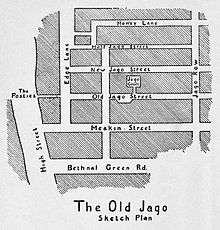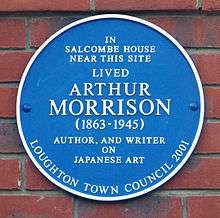Arthur Morrison
| Arthur Morrison | |
|---|---|
 | |
| Born |
1 November 1863 Poplar, London |
| Died |
4 December 1945 (aged 82) Chalfont St Peter, Buckinghamshire |
| Occupation | writer, journalist, art writer, art collector |
| Nationality | British |
| Subject | detective fiction, working-class life |
| Literary movement | Literary realism |
| Notable works | A Child of the Jago |
| Spouse | Elizabeth Thatcher |
| Children | Guy Morrison |
Arthur George Morrison (1 November 1863 – 4 December 1945) was an English writer and journalist known for his realistic novels and stories about working-class life in London's East End, and for his detective stories, featuring the detective Martin Hewitt. He also collected Japanese art and published several works on the subject. He left a large collection of paintings and other works of art to the British Museum after his death in 1945. Morrison's best known work of fiction is his novel A Child of the Jago (1896).
Early life
Morrison was born in Poplar, in the East End of London, on 1 November 1863. His father George was an engine fitter at the London Docks. George died in 1871 of tuberculosis, leaving his wife Jane with three children including Arthur. Arthur spent his youth in the East End. In 1879 he began working as an office boy in the Architect's Department of the London School Board. He later remembered frequenting used bookstores in Whitechapel Road around this time. In 1880 Arthur's mother took over a shop in Grundy Street. Morrison published his first work, a humorous poem, in the magazine Cycling in 1880, and took up cycling and boxing. He continued to publish works in various cycling journals.[1]
Career
In 1885 Morrison published his first serious journalistic work in the newspaper The Globe. In 1886, after having worked his way up to the rank of a third-class clerk, he was appointed to a position at the People's Palace, in Mile End. In 1888 he was given reading privileges at the British Museum. In the same year he published a collection of thirteen sketches entitled Cockney Corner, describing life and conditions in several London districts including Soho, Whitechapel, and Bow Street. In 1889 he became an editor of the paper Palace Journal, reprinting some of his Cockney Corner sketches, and writing commentaries on books and other subjects including the life of London poor people.[2]
In 1890 he left this job and joined the editorial staff of the The Globe and moved to lodgings in the Strand. In 1891 he published his first book The Shadows Around Us, a collection of supernatural stories. In October 1891 his short story A Street was published in Macmillan's Magazine. In 1892 he collaborated with illustrator J. A. Sheppard on a collection of animal sketches, one entitled My Neighbors' Dogs, for The Strand Magazine. Later that year he married Elizabeth Thatcher at Forest Gate. He befriended writer and editor William Ernest Henley around this time, publishing stories of working-class life in Henley's National Observer between 1892-94. His son Guy Morrison was born in 1893.[3]

In 1894 Morrison published his first detective story featuring the detective Martin Hewitt. In November he published his short story collection Tales of Mean Streets, dedicating the work to Henley. The collection was reviewed in 1896 in America by Jacob Riis. Morrison later said that the work was publicly banned. Reviewers of the collection objected to his story Lizerunt, causing Morrison to write a response in 1895. Later in 1894 he published Martin Hewitt, Investigator. In 1895 he was invited by writer and clergyman Reverend A. O. M. Jay to visit the Old Nichol Street Rookery.[4] Morrison continued to develop his interest in Japanese art, which he had been introduced to by a friend in 1890. Morrison began writing his novel A Child of the Jago in early 1896. The novel was published in November by Henley. It described in graphic detail living conditions in the East End, including the permeation of violence into everyday life (it was a barely fictionalised account of life in the Old Nichol Street Rookery). Morrison also published The Adventures of Martin Hewitt in 1896. A second edition of A Child of the Jago came out in 1897.[4]
In 1897 Morrison published seven short stories detailing the exploits of Horace Dorrington. In contrast to Morrison's earlier character Martin Hewitt, who one critic described as "low-key, realistic, lower-class answer to Sherlock Holmes," Dorrington was "a respected but deeply corrupt private detective," "a cheerfully unrepentant sociopath who is willing to stoop to theft, blackmail, fraud or cold-blooded murder to make a dishonest penny."[5] These stories were collected into a book titled The Dorrington Deed Box, also published in 1897.
In 1899 Morrison published To London Town as the final instalment of a trilogy including Tales of Mean Streets and A Child of the Jago. His work Cunning Murrell was published in 1900, followed by The Hole in the Wall in 1902. He continued to publish a wide variety of works throughout the 1900s, including short story collections, one act plays, and articles on Japanese art. In 1906 he sold a collection of Japanese woodcuts to the British Museum.[6] He also published a play in collaboration with his neighbour, Horace Newte.
Morrison lived and wrote successively at Chingford and Loughton.
Later life

In 1911 he published his authoritative work Japanese Painters, illustrated with paintings from his own collection. A sixth edition of A Child of the Jago came out the same year. In 1913 he retired from journalistic work, moving to a home in High Beach in Epping Forest. His son Guy joined the army in 1914 to serve in World War I. The same year Morrison sold his collection of Japanese art to Sir Watkin Gwynn Evans for £4000. Morrison continued to publish works about art. In 1915 Morrison served as a special constable in Essex, and was credited with reporting news of the first Zeppelin raid on London. In 1921 Guy Morrison died of malaria. Morrison was elected as a member of the Royal Society of Literature in 1924.[7]
In 1930 he moved to his last home in Chalfont St Peter, Buckinghamshire. In 1933 he published the short story collection Fiddle o'Dreams and More. In 1935 he was elected to the council of the Royal Society of Literature. Morrison died in 1945. In his will he left his collection of paintings, and woodcuts, and a collection of ceremonial tea porcelain to the British Museum. He also directed that his library be sold and his papers burnt.[8]
Legacy
The Arthur Morrison Society was formed in 2007. The Society's first public event was a reading by Morrison's grave, followed by a talk by Stan Newens. He later wrote a book about Morrison. Since then, the Morrison Society has organised talks and other events as part of the Loughton Festival. These included a talk by Tim Clark (The British Museum) about Morrison's Japanese print collection.[9] There is a blue plaque to him near the site of his Loughton house, Salcombe Lodge.
Literary works
- Tales of Mean Streets (1894)
- Martin Hewitt, Investigator (1894)
- Zig-Zags At The Zoo (1894)
- The Chronicles of Martin Hewitt (1895)
- The Adventures of Martin Hewitt (1896)
- A Child of the Jago (1896)
- The Dorrington Deed Box (1897)
- To London Town (1899)
- Cunning Murrell (1900)
- The Hole in the Wall (1902)
- The Red Triangle (1903)
- The Green Eye of Goona - The Green Diamond (US title) (1904)
- Divers Vanities (1905)
- Green Ginger (1909)
- Fiddle o'Dreams And More (1933)
Notes
- ↑ Miles 2012, p. xxxi.
- ↑ Miles 2012, p. xxxii.
- ↑ Miles 2012, p. xxxiii.
- 1 2 Miles 2012, p. xxxiv.
- ↑ Horace Dorrington - The Thrilling Detective
- ↑ Miles 2012, p. xxxv.
- ↑ Miles 2012, p. xxxvi.
- ↑ Miles 2012, p. xxxvii.
- ↑ "The Arthur Morrison Society". vpweb.co.uk. 2007. Retrieved 17 July 2012.
References
- Newens, Stan (2008). Arthur Morrison: The Novelist of Realism in East London and Essex. Alderton Press. ISBN 978-1-905269-10-5.
- Miles, Peter (2012). A Child of the Jago; Chronology of Arthur Morrison. Oxford University Press. ISBN 978-0-19-960551-4.
External links
| Wikisource has original text related to this article: |
- Works by Arthur Morrison at Project Gutenberg
- Works by Arthur Morrison at Project Gutenberg Australia
- Works by or about Arthur Morrison at Internet Archive
- Works by Arthur Morrison at LibriVox (public domain audiobooks)

- Adelaide University e-books of some of Morrison's stories
- Arthur Morrison Bio and Detective Hewitt Stories Illustrated by Sidney Paget
- Loughton Festival
- The Arthur Morrison Society
- The Jago: the blackest pit in London Radio 4, broadcast 1985
- "Horace Dorrington, Criminal-Detective: Investigating the Re-Emergence of the Rogue in Arthur Morrison's The Dorrington Deed-Box (1897)" by Clare Clarke, Clues: A Journal of Detection 28.2 (2010)